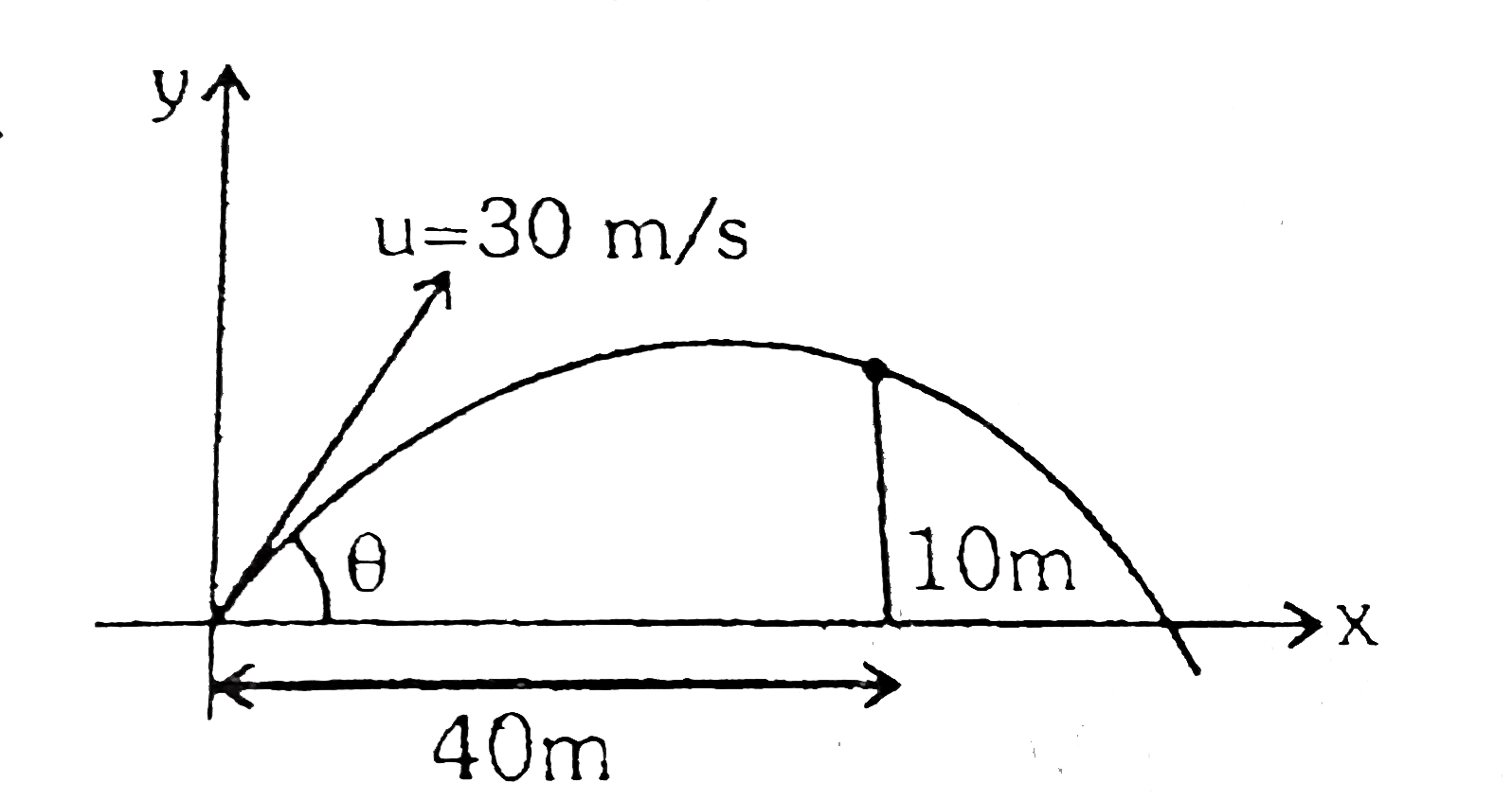Two trains, each 50 m long are travelling in opposite direction with velocity 10 m/s and 15 m/s. The time of crossing is
The correct Answer is:4

y=xtanθ−9x22u2cos2θ
10=40tanθ−10×1600(1+tan2θ)2×900
10=40tanθ−809−809tan2θ
89tan2θ−4tanθ+179=0
8tan2θ−36tanθ+17=0
tanα+tanβ=368
tanα+tanβ=178
tan(α+β)=tanα+tanβ1−tanαtanβ
=36/81−178=36/8−9/8=−4
So |tan(α+β)|=|−4|=4
Topper's Solved these Questions
- MOTION IN A PALNEBook:ALLENChapter:MOTION IN A PALNEExercise:Exercise-04[B]
Explore 14 Videos
- MOTION IN A PALNEBook:ALLENChapter:MOTION IN A PALNEExercise:Exercise-05 [A]
Explore 11 Videos
- MOTION IN A PALNEBook:ALLENChapter:MOTION IN A PALNEExercise:Comprehension#7
Explore 3 Videos
- KINEMATICS-2DBook:ALLENChapter:KINEMATICS-2DExercise:Exercise (O-2)
Explore 46 Videos
- NEWTON'S LAWS OF MOTION & FRICTIONBook:ALLENChapter:NEWTON'S LAWS OF MOTION & FRICTIONExercise:EXERCISE (JA)
Explore 4 Videos
Similar Questions
A boat is moving with a velocity 3ˆi+4ˆj with respect to ground. The water in the river is moving with a velocity −3ˆi−4ˆj with respect to ground. The relative velocity of the boat with respect to water is.
View SolutionA man wishes to swim across a river 0.5km. wide if he can swim at the rate of 2 km/h. in still water and the river flows at the rate of 1km/h. The angle (w.r.t. the flow of the river) along which he should swin so as to reach a point exactly oppposite his starting point, should be:-
View SolutionA graph between the square of the velocity of a particle and the distance(s) moved is shown in figure. The acceleration of the particle in kilometers per hour square is:-

View SolutionA particle is moving in the x-y plane. At certain instant of time, the components of its velocity and acceleration are as follows: vx=3ms−1,vy=4ms−1,ax=2ms−2anday=1ms−2. The rate of change of speed at this moment is
View SolutionA piece of wire is bent in the shape of a parabola y=kx2 (y-axis vertical) with a bead of mass m on it. The bead can slide on the wire without friction. It stays at the lowest point of the parabola when the wire is at rest. The wire is now accelerated parallel to the x-axis with a constant acceleration a. The distance of the new equilibrium position of the bead, where the bead can stay at rest with respect to the wire, from the y-axis is
View SolutionA 120 m long train is moving in a direction with speed 20 m/s . A traing B moving with 30 m/s in the opposite direction and 130 m long crosses the first train in a time
View SolutionTwo trains, each 50m long, are travelling in opposite directions with velocities 10ms−1and15ms−1. The time of their crossing each other is.
View SolutionA 100 m long train crosses a man travelling at 5 kmh^(-1) , in opposite direction, in 7.2 s then the velocity of train is
View Solutionदो रेलगाड़ियाँ समान्तर पटरियों पर एक - दूसरे की ओर जा रही है प्रत्येक रेलगाड़ियों की लम्बाई 50 मीटर है इनके वेग क्रमशः 10 मी/से तथा 15 मी/से है वे एक-दूसरे को पार करेंगी :
View Solution30 मी/ से की रफ्तार से चलती हुई 200 मी लम्बी रेलगाड़ी ,20 मी /से की रफ्तार से उसी दिशा में चलती हुई 300 मी लम्बी एक अन्य रेलगाड़ी को कितने समय में पार कर पाएगी ?
View SolutionThe 50 m long train travels at a speed of 10 m / s. Calculate the time it takes for the train to cross a power pole and a 250-meter-long bridge.
View SolutionTwo trains of lengths 80 m and 90 m are moving in opposite directions at 10 m/s and 7 m/s, respectively. Find the time taken by the trains to cross each other.
View SolutionTwo trains of lengths 70 m and 90 m are moving in opposite directions at 10 m/s and 6 m/s, respect- ively. Find the time taken by trains to cross each other.
View Solution50 मीटर लम्बाई की दो रेलगाड़ियाँ परस्पर विपरीत दिशा में 10 मी/सैकण्ड तथा 15 मी/सैकण्ड के वेग से गतिशील है। वे कितने समय में एक दूसरे को पार कर लेंगी
View SolutionTrain A 120 m long is moving with 20 m/s. Train B 130 m long is moving with 30 m/s in opposite direction. In what time, train B will cross train A?
View Solutionदो रेलगाड़ियाँ प्रत्येक 50 m लम्बी, परस्पर विपरीत दिशाओं में 10 m/s व 15 m/s वेग से गतिशील हैं। उन्हें एक दूसरे को पार करने में लगा समय होगा :-
View Solution
